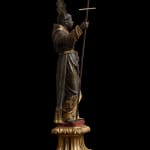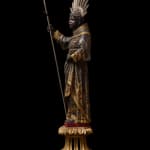SAINT BENEDICT OF PALERMO
Sgraffito and “estofado” work
Cross and halo in hammered and incised silver
Further images
Provenance
Private collection
St. Benedict of Palermo (San Fratello c. 1524 - Palermo 1589), also called Benedict the Black, Benedictthe Moor or Benedict of San Fratello. In Brazil he is also called São Benedito das Flores. The son ofAfrican slaves, he was a hermit before becoming a Franciscan. It is thought his parents worked on aplantation near Messina where they had been brought from Africa. In around 1564 he entered themonastery of Santa María in Palermo and, despite not being able to read or write, due to his saintlycharacter he was appointed guardian of the community, then vicar and master of services, and proved aninspiration to everyone, as he seemed to possess divine enlightenment. He subsequently went on to takeresponsibility for the kitchens, where he showed great humility and charity towards the needy. He diedin 1589. He was beatified by Pope Benedict XIV in 1743, and canonized in 1807 by Pius VII. He hasbecome the patron saint of African Americans and, in particular, black slaves.
Our beautiful and expressive free-standing sculpture of Saint Benedict the Moor, or Benedicto de Palermoas he is called in Brazil, is depicted standing on a plinth as a young man with exquisite and dulcet featuresthat also allude to his African heritage. He is dressed in the long-sleeved Franciscan habit, secured at thewaist with the typical rope belt, and a short cape or pelerine with a high neck and a triangular hood fallingdown his back. We can also observe the saint’s attributes: the cross and bunch of roses.
Benedict’s habit presents vertical folds towards the top, whereas the lower part is lavishly decoratedand infused with movement, being hitched up at the front by his left hand, which is also holding apot containing roses against his body. In his righthand he is holding a straight, simple and austeresilver cross, which as mentioned earlier is one ofhis attributes. The saint boasts a head of hair withdelicate and pronounced curls, crowned by a silverhalo with rays of light featuring floral motifs. Underhis habit we can make out two feet in sandalsresting ethereally on a cushion.
It is worth highlighting the great expressivenessof the young face, with its half-open mouth andsoft, deep gaze communicating both surprise andhumility, perhaps in wonder at one of the miraclesattributed to him. One of these is alluded to by theflowers the saint is hiding in the folds of his cloak;it was said he often gave the poor and meek foodfrom the convent stores, and on one occasion wasreprimanded by a superior. But, when he openedup his cloak, a bunch of roses fell to the floor.
The traditional Franciscan belt, consisting of arope with three knots, is highlighted in gold toemphasize the saint’s intercession in difficult births,a mediation he effected by means of his belt.
It is also worth mentioning the work’s skilful gilding,along with the sgraffito and estofado work on theclothing, which combines beautiful floral motifs that stand out against the expressive sgraffito of subtle lines executed with great dramatic effect. The lower hemof the cloak and the edges of the pelerine are also highlighted with gold leaf, and decorated with roundpunchmarks and both linear and plant ornamentation.
As mentioned earlier, attention is drawn to the saint’s miracles through great use of polychromy, as maybe seen in the bunch of roses with its varying tones of red, and in the gold leaf applied to the Franciscanbelt with its three knots, which stands out against the dark Franciscan habit that attempts to simulatebrown flannel.
Throughout the 18thcentury, Brazil underwent a major period of economic splendour due to theexploitation of its gold and diamond mines in the Minas Gerais region. This wealth attracted bothEuropean and local artistic talent, and gave rise to a Baroque era of great importance, with a particularblossoming of the art of sculpture. However, given the majority of works prior to the 20thcentury wereunsigned, any attempt to attribute them faces various obstacles, though that has not stopped a numberof names coming to the fore. It is important to point out that this artistic style did not reach the countryuntil well into the 18thcentury, largely through Portuguese émigrés, and that it quickly adopted veryparticularly characteristics, above all in the wealthy Minas Gerais area, as mentioned above.
This sculpture belongs to the Brazilian school, as is clearly demonstrated by the saint’s features.One of the most important genres of viceregal art was the depiction, both in painting and sculpture, ofblack saints. Religion and slavery were two essential elements enabling the Portuguese crown to achieve
its goals in the colonization of the Americas. In various regions of Brazil, including Minas Gerais andthe north-east of the country, confraternities were formed by and for slaves, whose worship centeredon black saints of African origin. In the evangelical process throughout Africa and the Americas, onedevotional object proved particularly efficient in the 16thcentury: the rosary. The devotion born ofthe appearance of the Virgin Mary to St. Dominic in 1218 spread among Europeans through theDominicans, whose friars welcomed the blacks arriving in Lisbon. Nossa Senhora do Rosario dosHomens Pretos (Our Lady of the Rosario of Black Men) is one of the most widespread confraternitiesin Recife, whose church included altars dedicated to Sts. Elesbaan, Benedict of Palermo, Anthony ofCatalagirona, Moses the Hermit, Iphigenia and Melchior, all of African origin. These brotherhoods ofblack men constituted privileged pockets of liberty, although not of equality with white men. Given thenumber of renowned Brazilian artists of African descent working during the colonial period, it seemsquite feasible that the creators of sculptures depicting black saints might themselves be black or mixedrace sculptors, although there is no recorded information on said artist
Depicting black saints was one of the Catholic Church’s strategies aimed at the sought-after catechesisand evangelization of the black slave population, recently arrived on the Portuguese colony. Thecombination of black saints with traditional ones also constituted a form of religious syncretism.The search for moral virtues in the lives of black saints contributed to combatting undesired habitsand customs, which would generate social disorder. They sought to establish a profile for the faithfulthat cultivated humility and prayer, and to this end made use of the history of saints and developedhagiographies that would assist the good and faithful Catholics.
St. Benedict of Palermo was venerated, and his virtues, goodness, charity and excellence were exaltedto illustrate the Christian predisposition of blacks and those of mixed race. In his hagiographies,much of the focus is on his poverty, obedience, chastity, proclivity for fasting, humility, prayer andalso his many miracles, mostly aimed at children, and both rich and poor men and women. Particularemphasis is given to medical subjects such as the healing of the blind and his intercession in childbirthcomplications. In building up this Christian model based on a black saint from Sicily, the intention wasto portray him as an example for the African population to follow, which would serve as a tool for their social integration.









